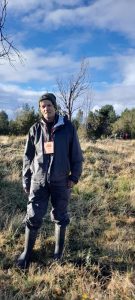By Reinhard Fitzek, Head of Restoration Laboratory of Innovation and Sustainability UÑU and Master in Forest Sciences.
Natural organic soil is the matrix that sustains life, both of terrestrial ecosystems with all their biodiversity and that of our species. The thin layer of soil that is measured in decimeters and has been formed over millennia, millimeter by millimeter, through highly complex physical, chemical, and biological processes, is a fragile substratum subject to being damaged to the point of being lost by human interventions of all kinds.
In general terms, as a society we are aware of the damage caused by deforestation, such as: forest fires, inadequate agricultural practices and the loss of soil due to the increasing urbanization of formerly rural areas. From the local point of view, a special aspect of urbanization in Chiloé is the tendency to parcel out agricultural properties for their transformation into places of liking that leads to an increasing fragmentation of forest cover and also of soils that centuries ago have been used for Chilota’s classic subsistence agriculture, recognized with the GIAHS seal, an acronym referring to the Important Systems of World Agricultural Heritage, for its sociocultural value and its intrinsically sustainable ancestral practices.
In this context, a new phenomenon that generates a growing impact calls attention. The existence of more and more heavy machinery in the hands of small companies has generated an earthmoving market that is no longer limited to the opening of public and private roads (intra-property), but rather facilitates the leveling of construction sites, both for dwelling houses and larger building complexes. Bulldozers are also used for clearing and modifying the landscape, with less and less regard for both scenic beauty and basic ecosystem services at the landscape level. It gives the impression that anyone, in order to prove ownership of a piece of land, can arrogate to intervene in the landscape. We are seeing how the organic forms of the well-known “soft hills” of the Chilote rural world present more and more wounds in the form of cuts and artificial slopes. Awareness is needed, but also regulation with effective sanctions to protect areas of rural land, the legacy of millennia of geological and ecological history of our mother earth.
As scientists motivated by the restoration of ecosystems and the recovery of the native forest, we have been planting throughout June, and this weekend we will hold the Shovel in Hand Conservation Festival, which seeks precisely to work on the conservation of Chilote soil, from the hand of civil society, territorial authorities, the private sector and academia. The initiative seeks to plant 10,000 trees and meets the standards of Ecological Restoration, a forestry and environmental discipline that aims to rebuild ecosystems as close to those that existed in places prior to human intervention.
We need not just sustainable intentions, but action plans. In this sense, our reforestation plan with species such as coihue, canelo, ulmo, notro, arrayán, luma, meli, olivillo, mañío, maqui, trevo and tiaca, will partly offset the damage caused to our soil. These types of actions make it possible to increase the mass of native forest, restore the soil and improve its quality, enhance the capacity to capture carbon dioxide, create biological corridors, improve the capacity to retain drinking water, protect flora and fauna from island, and contribute to limit the increase in temperature on the planet. It’s just about giving back to our environment… let’s work together?.





![[Img #74664]](https://thelatestnews.world/wp-content/uploads/2024/12/James-Watson-The-controversial-genius-behind-the-double-helix-150x150.jpg)








![[Img #74664]](https://thelatestnews.world/wp-content/uploads/2024/12/James-Watson-The-controversial-genius-behind-the-double-helix-300x200.jpg)

